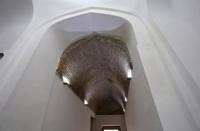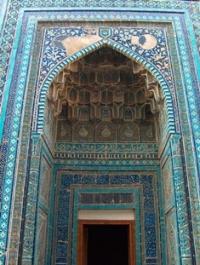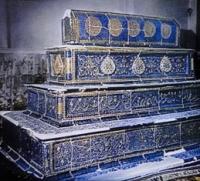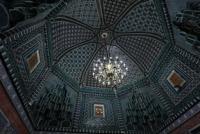Вы здесь
Сomplex Kusam ibn Abbas.




Familiarization tour tour on necropolis Shakhi-Zinda.
“Ancient aphorisms outlived centuries. Modern aphorisms can barеly survive from book to book”
Ljupka Cvetanova.
Tourist trip in Samarkand.
The mausoleum of Kusam ibn Abbas is located on Shah-i-Zinda street, on the northern outskirts of Samarkand, on the edge of the Afrasiab hill at the Shah-i-Zinda mausoleum and burial complex. “The Prophet Arabian, Hashimite, Qureishite, Meccan and Medinian said greeting him: Al-Kusam ibn al-Abbas reminds me by appearance and character more than any other man”.
The entrance there is a square mosaic panel with inscription. By the X – XI centuries, martyr Kusam ibn Abbas had already obtained a status of Islamic saint and patron of Samarkand. His belonging to the dynasty of the Abbasids, reigning in the Caliphate, promoted that.
In the 1220s, the Mongols, having destroyed Samarkand, did not touch this sacred place. In the 1330s, when Arabian traveler Ibn Battuta visited this esteemed holy place, emir Giyas ad-Din Muhammad from descendants of the Abbasids was a keeper of the tomb.
Here was Sufi khanaka with rooms for pilgrims, which operated in account of donations. Sufi ritual of loud dhikr had been carried out near the tomb of Kusam ibn Abbas down to the end of the XIX century.
Small gurkhana with the gravestone formed the first mausoleum of Kusam ibn Abbas. It was built in the XI century and had been preserved up to the Qarakhanid time. Gurkhana was built from rectangular bricks and covered by a small dome on archaic arch pendentives.
The building had no foundations, in usual understanding of this word. Just the wooden beam formed a basis of the walls. The interior of gurkhana is very simple. Ganch plaster came into practice just in the XIV century.
The northern observing niche has wooden pandjara. Gurkhana adjoins ziaratkhana – a wide memorial room with mihrab in the western wall, also constructed in the XI century. The inscription on arch pendentive reads that in 1334 - 1335, the dome of ziaratkhana was reconstructed and coated with carved enameled terracotta of green-bluish color.
The walls faced with ganch bear traces of numerous repairs and have some layers of polychromic paintings, dated from the XI - XII, XIV, XV and XIX centuries. The carved wooden door in the northeastern corner dates from the XIV century or earlier.
Kufi inscription in the upper part of the ornament reads: “Pray, but not power and property”. Under ziaratkhana there is a premise for sole forty-day pray - chillyakhana, built in the XI century.
In the western wall of chillyakhana there is mihrab with two windows at the sides. In the eastern wall, there are two niches for lamps. In the mid-XV century, flat ceiling of chillyakhana was replaced by the vault, existing to this day.
At the northern side of chillyakhana was a staircase going to above-ground premises. Above the entrance there is a square mosaic panel with inscription: “the Prophet Arabian, Hashimite, Qureishite, Meccan and Medinian said greeting him: Al-Kusam ibn al-Abbas reminds me by appearance and character more than any other man”.
Beside the entrance to the necropolis, there is a small, but very ancient minaret of the XI century. In the territory of Central Asia, it is only sample of a cylindrical body on a rectangular plinth.
The body is made from pairs of bricks with bow-shaped inserts, decorated with crosswise cuts. Current height of the minaret - 12 m. Its top was rebuilt from ancient figured bricks with rhombuses and diagonal squares.
Geographic coordinates of the Kusam ibn Abbas mausoleum: N39 ° 39'47.13 "E66 ° 59'17.66"
Authority:
Alexey Arapov. Samarkand. Masterpieces of Central Asia. Tashkent, Sanat. 2004.







